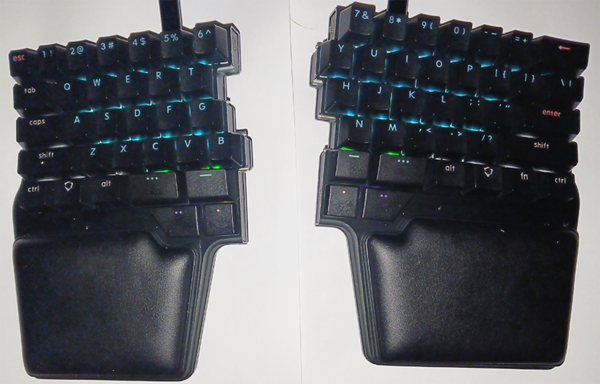A starter ergonomic keyboard: The Dygma Raise 2
Ready for Action?

Gaming keyboards often include more features than standard keyboards. Many are hot swappable mechanical boards with a limited number of programmable keys. However, even top-of-the-line gaming boards such as Razer's BlackWidow are limited compared to high-end ergonomic boards. Founded by professional gamer Luis "Deilor" Sevilla, Dygma aims to bridge that gap with the Raise 2 (Figure 1), a board that introduces some but not all the features of fully ergonomic boards. The goal is an ambitious one, as reflected in the company name, which is derived from the Spanish word for "paradigm." The result is a keyboard suitable for both gamers and a general audience, although the design decisions are a mixed success. While some are efficient, others seem to be made with conflicting intents and without consideration of the user experience.
The Raise 2 has several of the features of the newest generation of ergonomic keyboards. These include:
[...]
Buy Linux Magazine
Subscribe to our Linux Newsletters
Find Linux and Open Source Jobs
Subscribe to our ADMIN Newsletters
Support Our Work
Linux Magazine content is made possible with support from readers like you. Please consider contributing when you’ve found an article to be beneficial.

News
-
Two New Distros Adopt Enlightenment
MX Moksha and AV Linux 25 join ranks with Bodhi Linux and embrace the Enlightenment desktop.
-
Solus Linux 4.8 Removes Python 2
Solus Linux 4.8 has been released with the latest Linux kernel, updated desktops, and a key removal.
-
Zorin OS 18 Hits over a Million Downloads
If you doubt Linux isn't gaining popularity, you only have to look at Zorin OS's download numbers.
-
TUXEDO Computers Scraps Snapdragon X1E-Based Laptop
Due to issues with a Snapdragon CPU, TUXEDO Computers has cancelled its plans to release a laptop based on this elite hardware.
-
Debian Unleashes Debian Libre Live
Debian Libre Live keeps your machine free of proprietary software.
-
Valve Announces Pending Release of Steam Machine
Shout it to the heavens: Steam Machine, powered by Linux, is set to arrive in 2026.
-
Happy Birthday, ADMIN Magazine!
ADMIN is celebrating its 15th anniversary with issue #90.
-
Another Linux Malware Discovered
Russian hackers use Hyper-V to hide malware within Linux virtual machines.
-
TUXEDO Computers Announces a New InfinityBook
TUXEDO Computers is at it again with a new InfinityBook that will meet your professional and gaming needs.
-
SUSE Dives into the Agentic AI Pool
SUSE becomes the first open source company to adopt agentic AI with SUSE Enterprise Linux 16.


